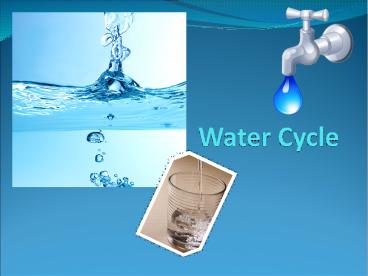Water Cycle PowerPoint PPT Presentation
Title: Water Cycle
1
Water Cycle
2
Water Cycle
- Water is always on the move. Rain falling where
you live may have been water in the ocean just
days before. And the water you see in a river or
stream may have been snow on a high mountaintop.
- The water cycle is also known as the hydrologic
cycle. - Fun Fact
- Hydro is Latin for water
3
Where is water?
- Water can be in the atmosphere, on the land, in
the ocean, and even underground. It is recycled
over and over through the water cycle. - In the cycle, water changes state between liquid,
solid (ice), and gas (water vapor).
4
(No Transcript)
5
Stage 1 Evaporation
- Evaporation is the change from liquid to vapor
form. - Evaporation turns the water that is on the
surface of oceans, rivers, lakes into water
vapor using energy from the sun. - What type of energy transfer is taking place?
6
Stage 1 Transpiration
- When water evaporates from plants it is a process
called transpiration. - Plants lose water through their stems, leaves,
and roots. - A fully grown tree may lose several hundred
gallons of water through its leaves on a hot, dry
day.
7
Stage 2 Condensation
- Condensation is the process by which water vapor
in the air is changed into liquid water. - The water vapor rises in the atmosphere and
cools, forming tiny water droplets by a process
called condensation. - Those water droplets make up clouds.
8
Stage 3 Precipitation
- Those water droplets that CONDENSE make up
clouds. If those tiny water droplets combine with
each other they grow larger and eventually become
too heavy to stay in the air. Then they fall to
the ground as rain, snow, and other types of
precipitation.
9
Stage 3 Precipitation
- Precipitation is water released from clouds in
the form of rain, freezing rain, sleet, snow, or
hail. It is the primary way water is delivered
from the atmosphere to the Earth.
10
Did you know
- How many gallons of water fall when 1 inch (2.5
cm) of rain falls on 1 acre of land? - 27,154 gallons of water!
- Rain drops are not tear shaped.
- They start out in a ball shape, but as they fall
they meet with air resistance, which starts to
flatten out the drop until at about 2-3 mm in
diameter the bottom is quite flat with an
indention in the middle - much like a hamburger
bun. When raindrops reach about 4-5 mm, things
really fall apart. At this size, the indentation
in the bottom greatly expands forming something
like a parachute with two smaller droplets at the
bottoms. The parachute doesn't last long, though,
and the large drop breaks up into smaller drops.
11
Wow! That is amazing!
- The world's record for average-annual rainfall
belongs to Mt. Waialeale, Hawaii, where it
averages about 450 inches (38 ft) per year. - The worlds recorded for least amount of rain
goes to Antofagasta Region, Atacama Desert, Chile
at 0 in one year! - It takes 6 gallons of water to grow the potatoes
for your order of fries! - For your hamburger it takes 1300 gallons of water
to produce everything needed!
12
Stage 4 Runoff
- The variety of ways by which water moves across
the land. - As it flows, the water may seep into the ground,
evaporate into the air, become stored in lakes or
reservoirs, or be extracted for agricultural or
other human uses.
13
Stage 4 Infiltration
- Some of the precipitation seeps into the ground
and becomes a part of the groundwater. - That seepage is called infiltration.
14
Stage 5 Accumulation
- The process in which water pools in large bodies
(like oceans, seas and lakes) Most of the water
on Earth is in the Ocean. - Did you know?
- Water stays in certain places longer than
others. A drop of water may spend over 3,000
years in the ocean before moving on to another
part of the water cycle while a drop of water
spends an average of just eight days in the
atmosphere before falling back to Earth.

